Applicability of Digital Image Photogrammetry to Rapid Displacement Measurements of Structures in Restricted-Access and Controlled Areas: Case Study in Korea
Abstract
1. Introduction
2. Materials and Methods
2.1. Field Investigation
2.2. Monitoring of the MSE Wall
2.3. Displacement Measurement Field Experiment on MSE Wall
3. Results and Discussion
3.1. Evaluating the Cause of Cracks on the MSE Wall Facing at the Case Site
3.2. Monitoring Results
3.3. Discussion of Applicability of Digital Image Photogrammetry
4. Conclusions
- The cause of the facing crack of the MSE wall in this research’s case study site was evaluated based on the results of the electrical resistivity survey. The evaluation results confirmed that an abnormal area occurred in the corner of the structurally vulnerable MSE wall due to the groundwater infiltration of the original ground and reinforced earth mass. In other words, it was observed that it caused the facing crack and deformation of the MSE wall.
- In order to evaluate the applicability of digital image photogrammetry in restricted-access and controlled areas, the displacement of the MSE wall was monitored using the traditional monitoring method and digital image photogrammetry. The monitoring results showed that the displacement values showed similar elapsed time trends for both methods, but digital image photogrammetry results exhibited larger displacements than the traditional monitoring results. Nevertheless, the error of the digital camera applied for digital image photogrammetry was lower than that of the cellphone camera.
- In order to evaluate the accuracy of digital image photogrammetry, the error rate was analyzed. The results showed that the error at a specific location was similar between the digital camera and the cellphone camera. However, it was found that digital image photogrammetry using a digital camera with a consistent error occurrence tendency is highly applicable to rapid structural deformation monitoring in restricted-access and controlled areas.
- It was found that research on the effect of the camera’s pixels on the error was necessary in order to improve the accuracy and error resolution of digital image photogrammetry using a digital camera. In addition, the effect of the aligned image on the accuracy of the measurement coordinates in the 3D transformation of the 2D image acquired from the digital camera must be studied. It was also evaluated that the position of the digital camera may have contributed to the error rate of the measurement results. Therefore, research should continue to evaluate the limitations of the image acquisition distance and angle of the digital camera.
Author Contributions
Funding
Institutional Review Board Statement
Informed Consent Statement
Data Availability Statement
Conflicts of Interest
References
- FHWA. Design of Mechanically Stabilized Earth Walls and Reinforced Soil Slopes-Volume I; FHWA-NHI-10-024; U.S. Department of Transportation: Washington, DC, USA, 2009.
- Passe, P.D. Mechanically Stabilized Earth Wall Inspector’s Handbook; State of Florida, Department of Transportation: Tallahassee, FL, USA, 2000.
- Yoo, C.; Jung, H.Y. Case History of Geosynthetic Reinforced Segmental Retaining Wall Failure. J. Geotech. Geoenviron. Eng. 2006, 132, 1538–1548. [Google Scholar] [CrossRef]
- Won, M.S.; Kim, Y.S. Internal deformation behavior of geosynthetic-reinforced soil walls. Geotext. Geomembr. 2007, 25, 10–22. [Google Scholar] [CrossRef]
- Bergado, D.T.; Teerawattanasuk, C. 2D and 3D numerical simulations of reinforced embankments on soft ground. Geotext. Geomembr. 2008, 26, 39–55. [Google Scholar] [CrossRef]
- Chen, R.H.; Chiu, Y.M. Model tests of geocell retaining structures. Geotext. Geomembr. 2008, 26, 56–57. [Google Scholar] [CrossRef]
- Li, A.L.; Rowe, R.K. Effects of viscous behavior of geosynthetic reinforcement and foundation soils on embankment performance. Geotext. Geomembr. 2008, 26, 317–334. [Google Scholar]
- Rowe, R.K.; Taechakumthorn, C. Combined effect of PVDs and reinforcement on embankments over rate-sensitive soils. Geotext. Geomembr. 2008, 26, 239–249. [Google Scholar] [CrossRef]
- Tatsuoka, F.; Hirakawa, D.; Nojiri, M.; Aizawa, H.; Nishikiori, H.; Soma, R.; Tateyama, M.; Watanabe, K. A new type of integral bridge comprising geosynthetic-reinforced soil walls. Geosynth. Int. 2009, 16, 301–326. [Google Scholar] [CrossRef]
- Oskouie, P.; Becerik-Gerber, B.; Soibelman, L. Automated measurement of highway retaining wall displacements using terrestrial laser scanners. Autom. Constr. 2016, 65, 86–101. [Google Scholar] [CrossRef]
- Rearick, A.; Khan, A. MSE Wall Design and Construction Policy Updates; State of Indiana, Department of Transportation: Indianapolis, IN, USA, 2017.
- Al-Rawabdeh, A.; Aldosari, M.; Bullock, D.; Habib, A. Mobile LiDAR for Scalable Monitoring of Mechanically Stabilized Earth Walls with Smooth Panels. Appl. Sci. 2020, 10, 4480. [Google Scholar] [CrossRef]
- Aldosari, M.; Al-Rawabdeh, A.; Bullock, D.; Habib, A. A Mobile LiDAR for Monitoring Mechanically Stabilized Earth Walls with Textured Precast Concrete Panels. Remote Sens. 2020, 12, 306. [Google Scholar] [CrossRef]
- Budhu, M. Soil Mechanics & Foundations; John Wiley & Sons, Inc.: Hoboken, NJ, USA, 2000. [Google Scholar]
- Bernhardt, K.L.S.; Loehr, J.E.; Huaco, D. Asset Management Framework for Geotechnical Infrastructure. J. Infrastruct. Syst. 2003, 9, 107–116. [Google Scholar] [CrossRef]
- Giresini, L.; Puppio, M.L.; Taddei, F. Experimental pull-out tests and design indications for strength anchors installed in masonry walls. Mater. Struct. 2020, 53, 103. [Google Scholar] [CrossRef]
- Palmeira, E.M. Soil-geosynthetic interation: Modelling and analysis. Geotext. Geomembr. 2009, 27, 368–390. [Google Scholar] [CrossRef]
- ASTM D 6706-01; Standard Test Method for Measuring Geosynthetic Pullout Resistance in Soil. ASTM Book of Standards. ASTM International: Philadelphia, PA, USA, 2003; Volume 4, p. 13.
- Hannah, M.J. A system for digital stereo image matching. Photogrammatic Eng. Remote Sens. 1989, 55, 1765–1770. [Google Scholar]
- El-Hakim, S.F.; Wong, K.W. Working group V/1: Digital and real-time close-range photogrammetry. In Proceedings of the SPIE Proceedings, Close-Range Photogrammetry Meets Machine Vision, Bellingham, WA, USA, 3–7 September 1990. [Google Scholar]
- Fraser, C.S. A resume of some industrial applications of photogrammetry. ISPRS J. Photogramm. Remote Sens. 1993, 48, 12–23. [Google Scholar] [CrossRef]
- Fraser, C.S. Full Automation of Sensor Calibration, Exterior Orientation and Triangulation in Industrial Vision Metrology. In Proceedings of the International Workshop on Image Analysis and Information Fusion, Adelaide, Australia, 6–7 November 1997; pp. 13–24. [Google Scholar]
- Oats, R.; Escobar-Wolf, R.; Oommen, T. A Novel Application of Photogrammetry for Retaining Wall Assessment. Infrastructures 2017, 2, 10. [Google Scholar] [CrossRef]
- Anderson, S.A.; Rivers, B.S. Capturing the Impacts of Geotechnical Features on Transportation System Performance. In Proceedings of the Geo-Congress, San Diego, CA, USA, 28 March 2013; pp. 1633–1642. [Google Scholar]
- Butler, C.J.; Gabr, M.A.; Rasdorf, W.; Findley, D.J.; Chang, J.C.; Hammit, B.E. RetainingWall Field Condition Inspection, Rating Analysis, and Condition Assessment. J. Perform. Constr. Facil. 2015, 30, 04015039. [Google Scholar] [CrossRef]
- Brutus, O.; Tauber, G. Guide to Asset Management of Earth Retaining STRUCTURES; US Department of Transportation, Federal Highway Administration, Office of Asset Management: Washington, DC, USA, 2009.
- Han, J.; Hong, K.; Kim, S. Application of a Photogrammetric System for Monitoring Civil Engineering Structures; InTech.: Rijeka, Croatia, 2012. [Google Scholar]
- Wyllie, D.; Mah, C. Rock Slope Engineering Civil and Mining, 4th ed.; Spon Press: New York, NY, USA, 2004. [Google Scholar]
- Scaioni, M.; Alba, M.; Roncoroni, F.; Giussani, A. Monitoring of a SFRC retaining structure during placement. Eur. J. Environ. Civ. Eng. 2010, 14, 467–493. [Google Scholar] [CrossRef]
- Wang, G.; Philips, D.; Joyce, J.; Rivera, F. The integration of TLS and continuous GPS to study landslide deformation: A case study in Puerto Rico. J. Geod. Sci. 2011, 1, 25–34. [Google Scholar] [CrossRef]
- Vaghefi, K.; Oats, R.; Harris, D.; Ahlborn, T.; Brooks, C.; Endsley, K.; Roussi, C.; Shuchman, R.; Burns, J.; Dobson, R. Evaluation of Commercially Available Remote Sensors for Highway Bridge Condition Assessment. J. Bridge Eng. 2012, 17, 886–895. [Google Scholar] [CrossRef]
- Escobar-Wolf, R.; Oommen, T.; Brooks, C.; Dobson, R.; Ahlborn, T. Unmanned Aerial Vehicle (UAV)-based Assessment of Concrete Bridge Deck Delamination Using Thermal and Visible Camera Sensors: A Preliminary Analysis. Res. Nondestr. Eval. 2017, 29, 183–198. [Google Scholar] [CrossRef]
- Jiang, R.; Jauregui, D.V.; White, K.R. Close-Range Photogrammetry Applications in Bridge Measurement: Literature Review. Measurement 2008, 41, 823–834. [Google Scholar] [CrossRef]
- Gong, J.; Zhou, H.; Gordon, C.; Jalayer, M. Mobile Terrestrial Laser Scanning for Highway Inventory Data Collection. Comp. Civ. Eng. 2012, 2012, 545–552. [Google Scholar] [CrossRef]
- Olsen, M.J.; Butcher, S.; Silvia, E.P. Real-Time Change and Damage Detection of Landslides and Other Earth Movements Threatening Public Infrastructure; Transportation Research and Education Center (TREC): Portland, OR, USA, 2012; OTREC-RR-11-23. [Google Scholar]
- Xiao, R.; He, X. GPS and InSAR Time Series Analysis: Deformation Monitoring Application in a Hydraulic Engineering Resettlement Zone, Southwest China. Math. Prob. Eng. 2013, 2013, 601209. [Google Scholar] [CrossRef]
- Casagli, N.; Cigna, F.; Bianchini, S.; Hölbling, D.; Füreder, P.; Righini, G.; Vlcko, J. Landslide mapping and monitoring by using radar and optical remote sensing: Examples from the EC-FP7 project SAFER. Remote Sens. Appl. Soc. Environ. 2016, 4, 92–108. [Google Scholar] [CrossRef]
- Laefer, D.; Lennon, D. Viability assessment of terrestrial LiDAR for retaining wall monitoring. In Proceedings of the American Society of Civil Engineers, GeoCongress 2008: Geosustainability and Geohazard Mitigation, New Orleans, LA, USA, 9–12 March 2008; pp. 247–254. [Google Scholar]
- Fischler, M.A.; Bolles, R.C. Random sample consensus: A paradigm for model fitting with applications to image analysis and automated cartography. Commun. ACM 1981, 24, 381–395. [Google Scholar] [CrossRef]
- Lin, Y.J.; Habib, A.; Bullock, D.; Prezzi, M. Application of High-Resolution Terrestrial Laser Scanning to Monitor the Performance of Mechanically Stabilized EarthWalls with Precast Concrete Panels. J. Perform. Constr. Facil. 2019, 33, 04019054. [Google Scholar] [CrossRef]
- Lienhart, W.; Monsberger, C.; Kalenjuk, S.; Woschitz, H. High Resolution Monitoring of Retaining Walls with Distributed Fibre Optic Sensors and Mobile Mapping Systems. In Proceedings of the 7th Asia-Pacific Workshop on Structural Health Monitoring, Hong Kong, China, 12–15 November 2018. [Google Scholar]
- Kraus, K. Photogrammetry: Geometry from Images and Laser Scans; Walter de Gruyter: Berlin, Germany, 2007; ISBN 978-3-11-019007-6. [Google Scholar]
- Golparvar-Fard, M.; Balali, V.; de la Garza, J.M. Segmentation and recognition of highway assets using image-based 3D point clouds and semantic Texton forests. J. Comp. Civ. Eng. 2012, 29, 04014023. [Google Scholar] [CrossRef]
- Cleveland, L.; Wartman, J. Principles and Applications of Digital Photogrammetry for Geotechnical Engineering. Proc. Site Geomat. Charact. 2006, 16, 128–135. [Google Scholar]
- Westoby, M.J.; Brasington, J.; Glasser, N.F.; Hambrey, M.J.; Reynolds, J.M. Structure-for-Motion’ photogrammetry: A low-cost, effective tool for geoscience applications. Geomorphology 2012, 179, 300–314. [Google Scholar] [CrossRef]
- Wolf, P.R.; Dewitt, B.A. Elements of Photogrammetry: With Applications in GIS, 3rd ed.; McGraw-Hill Co. Inc.: New York, NY, USA, 2000. [Google Scholar]
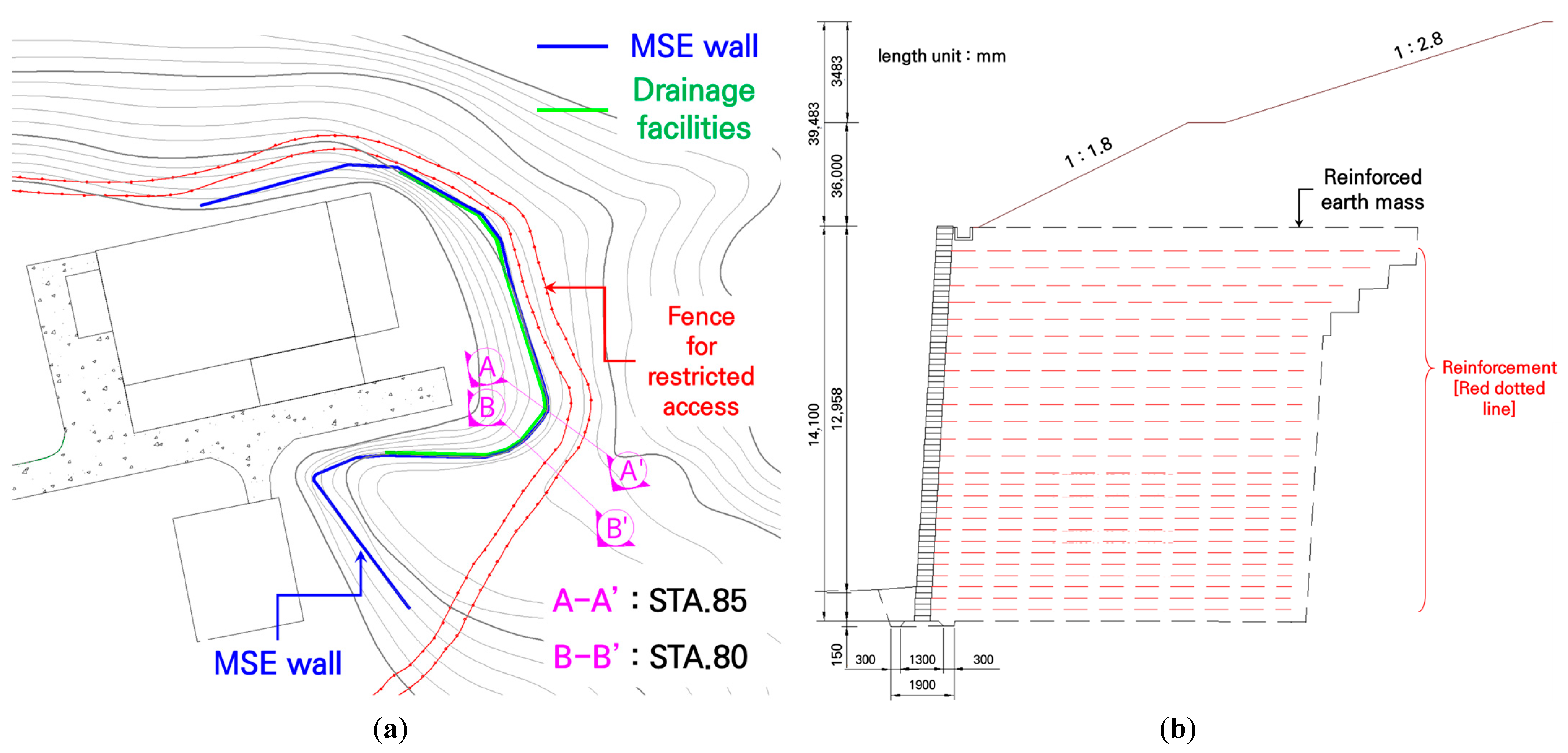
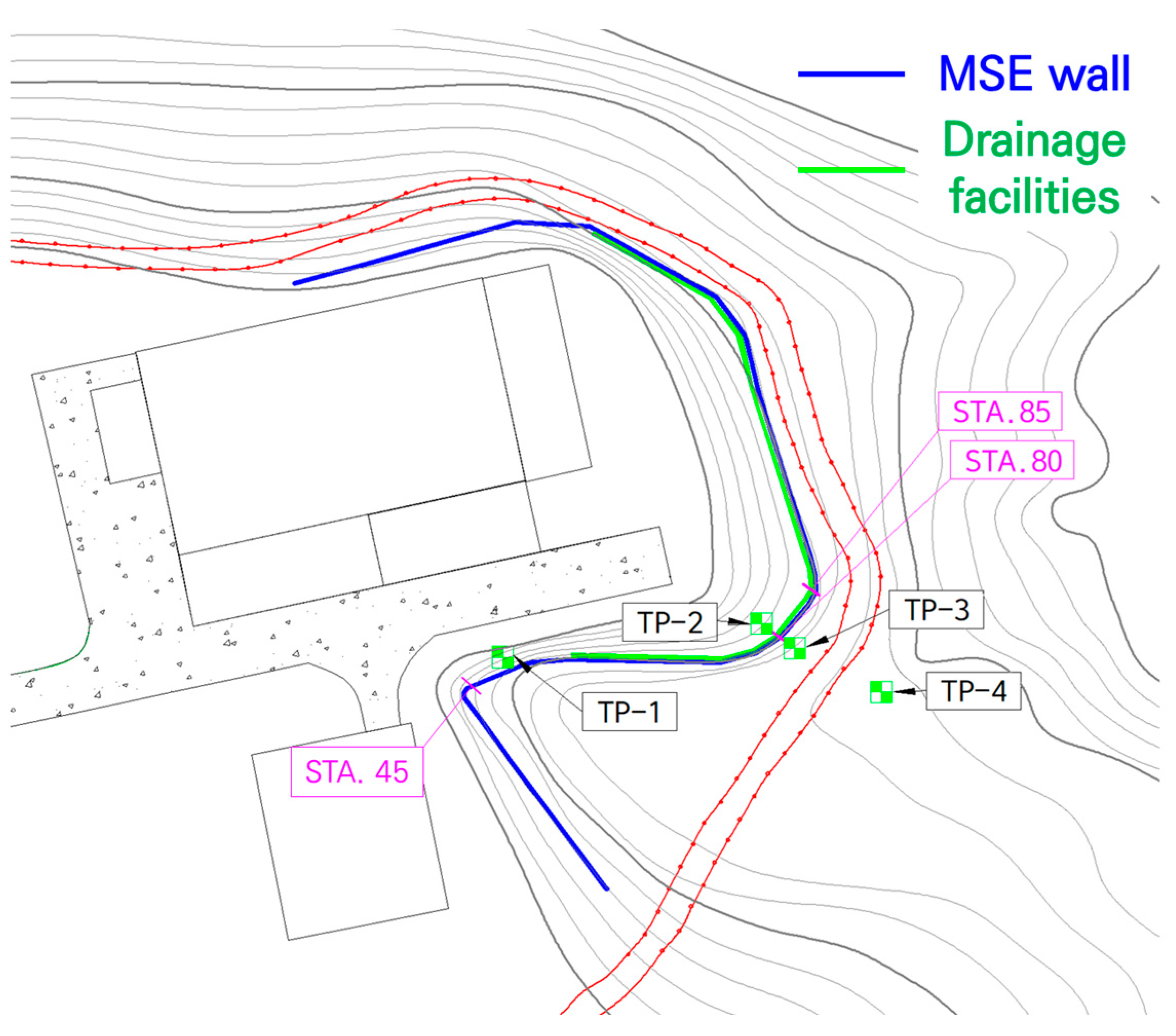
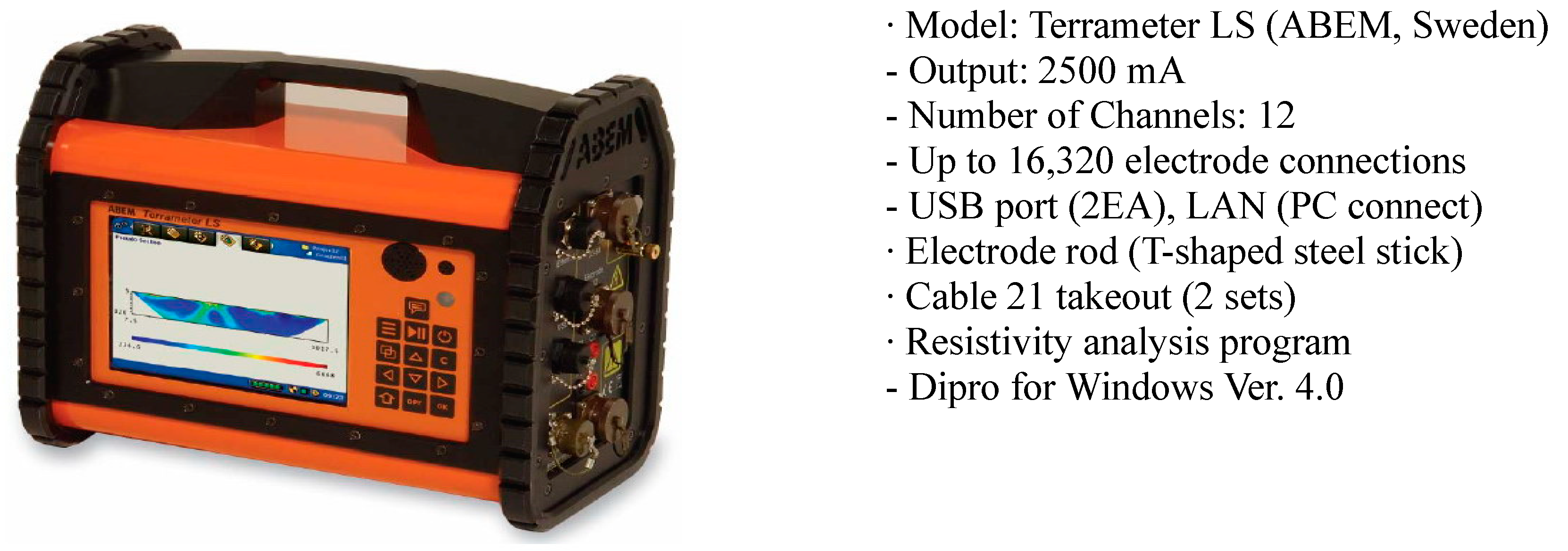
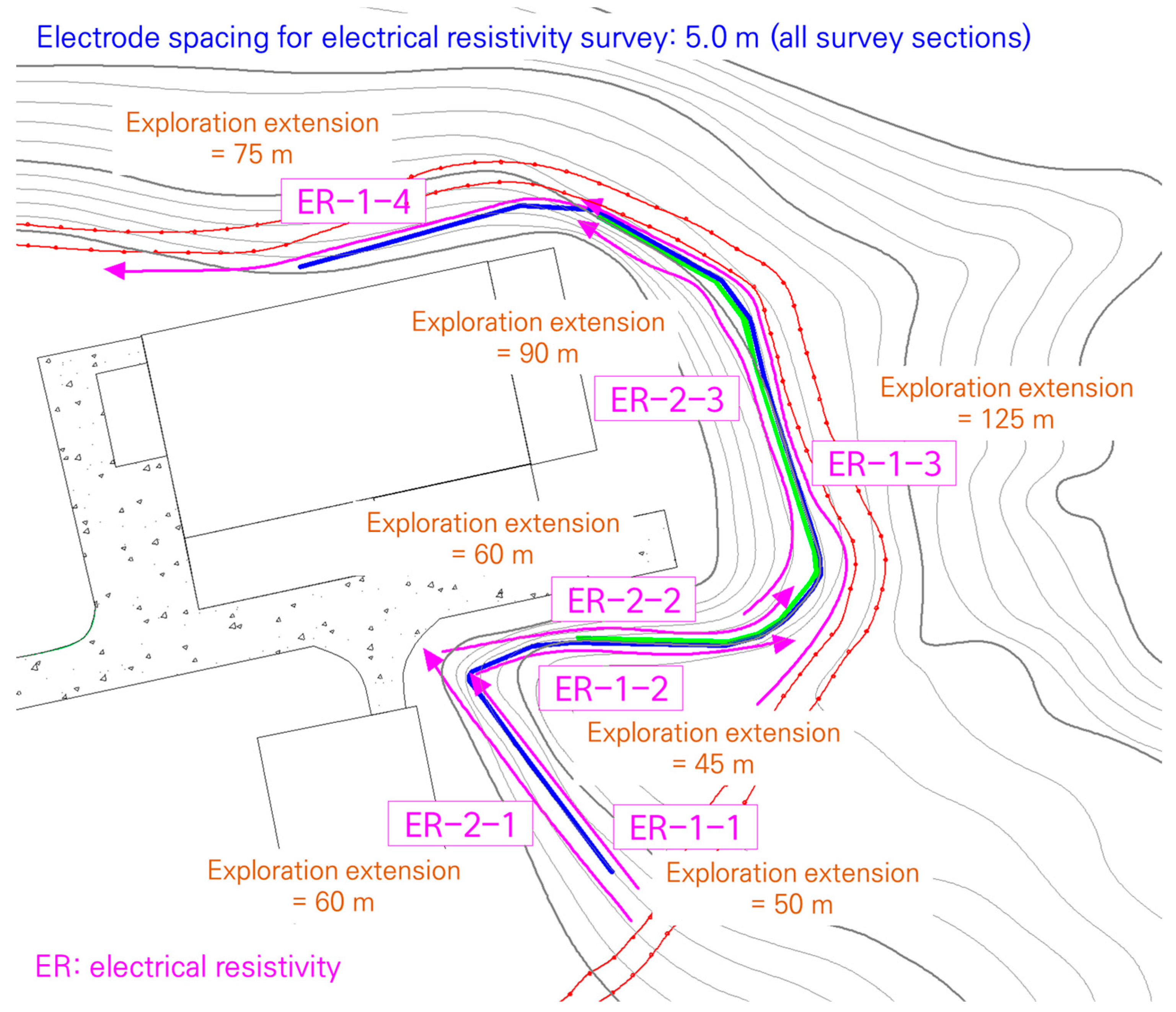
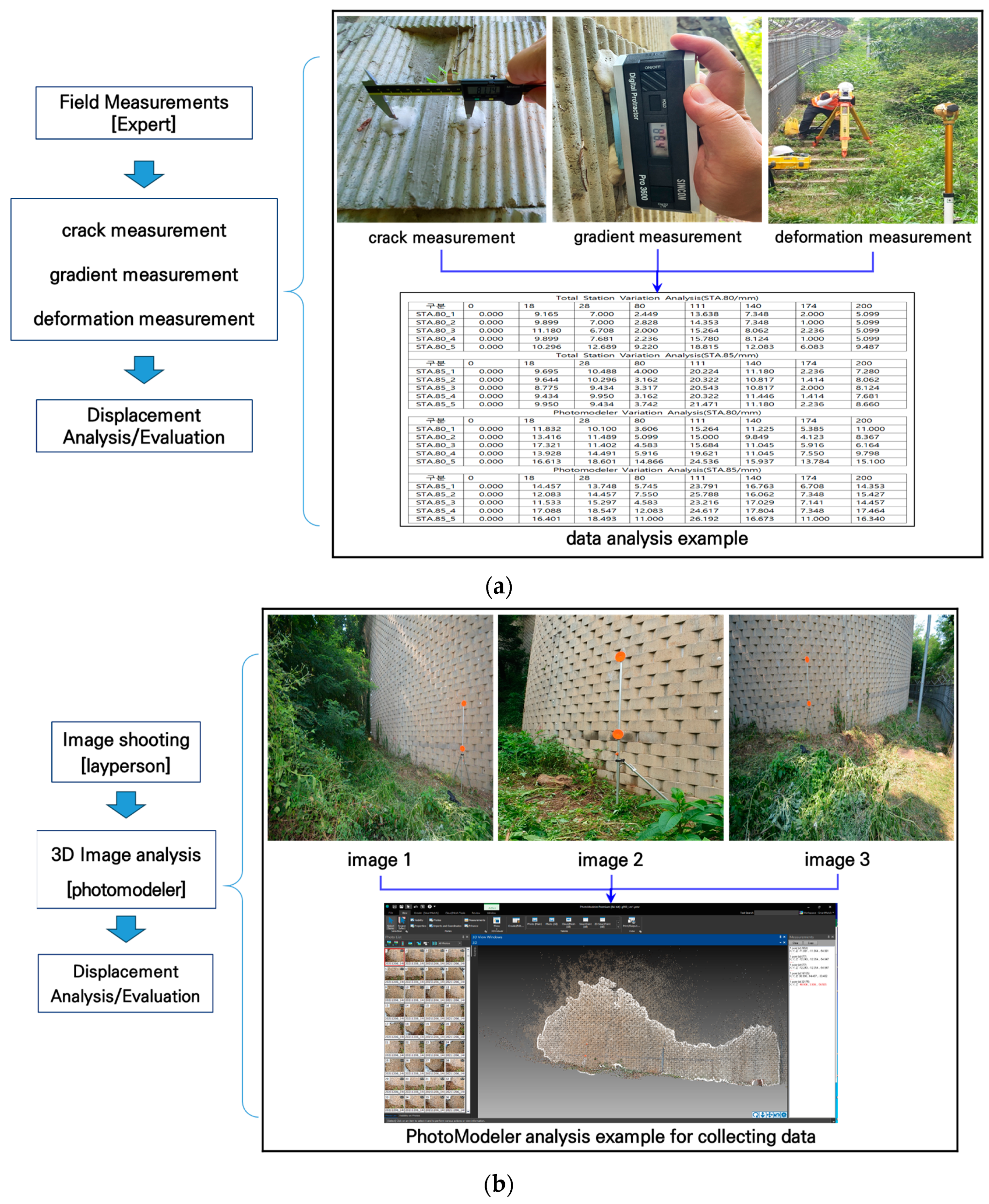
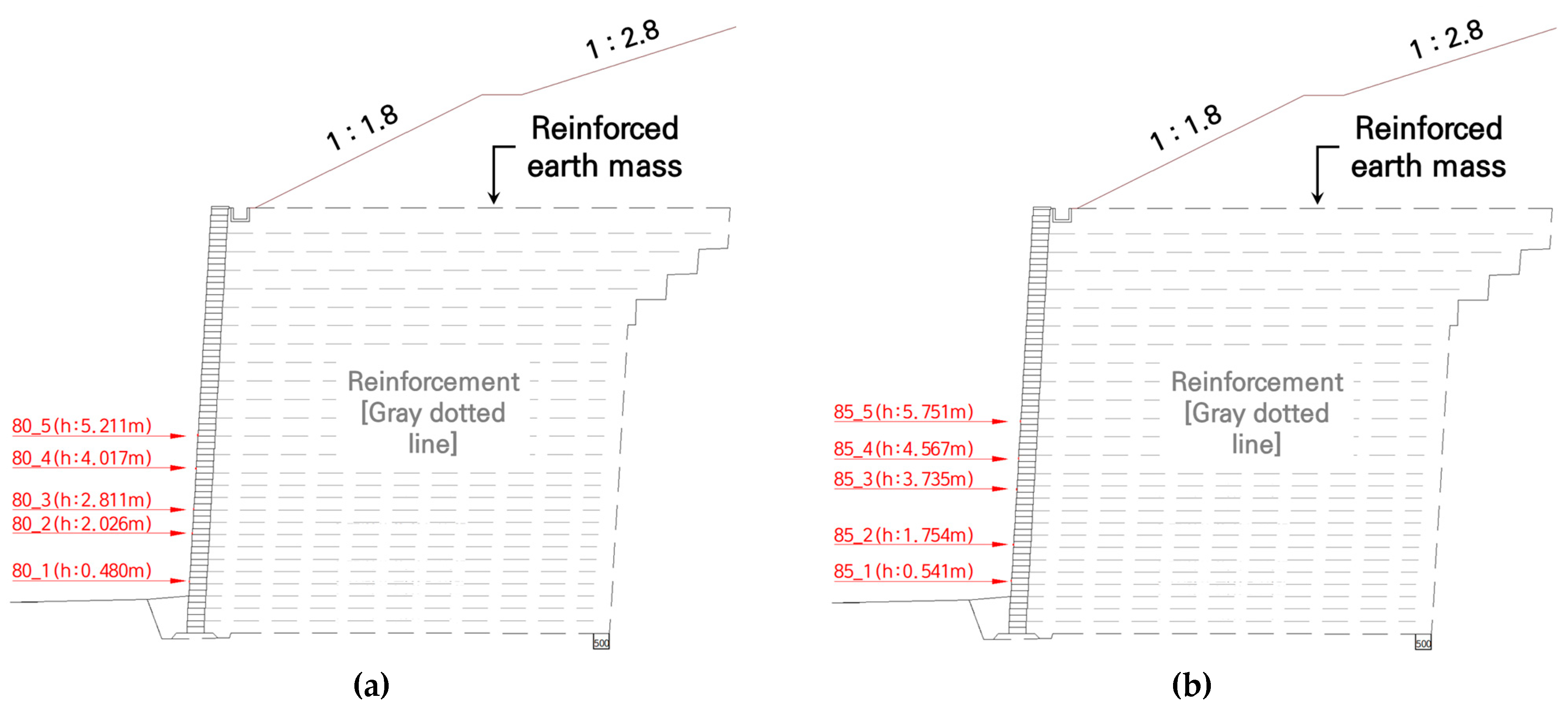

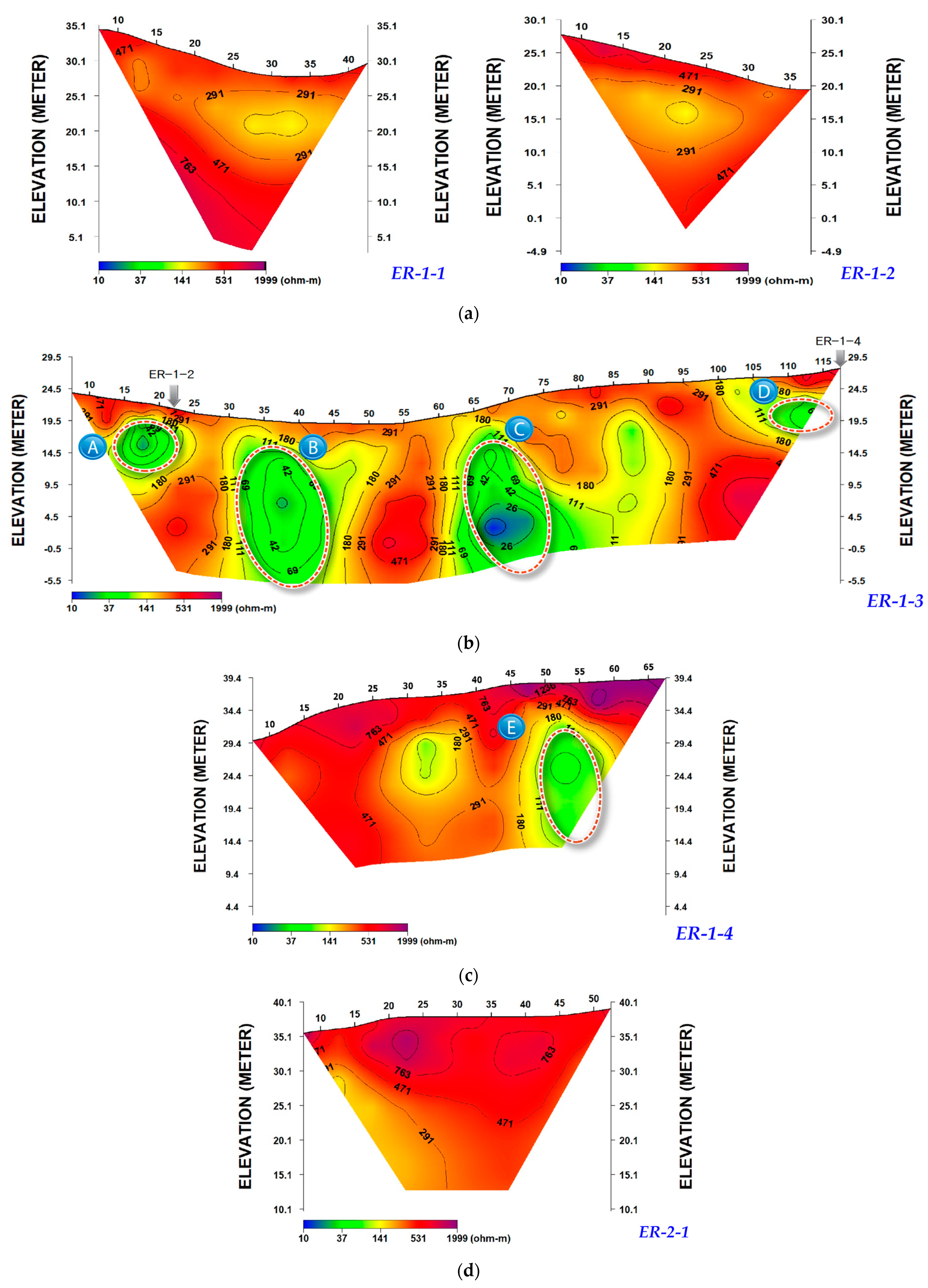

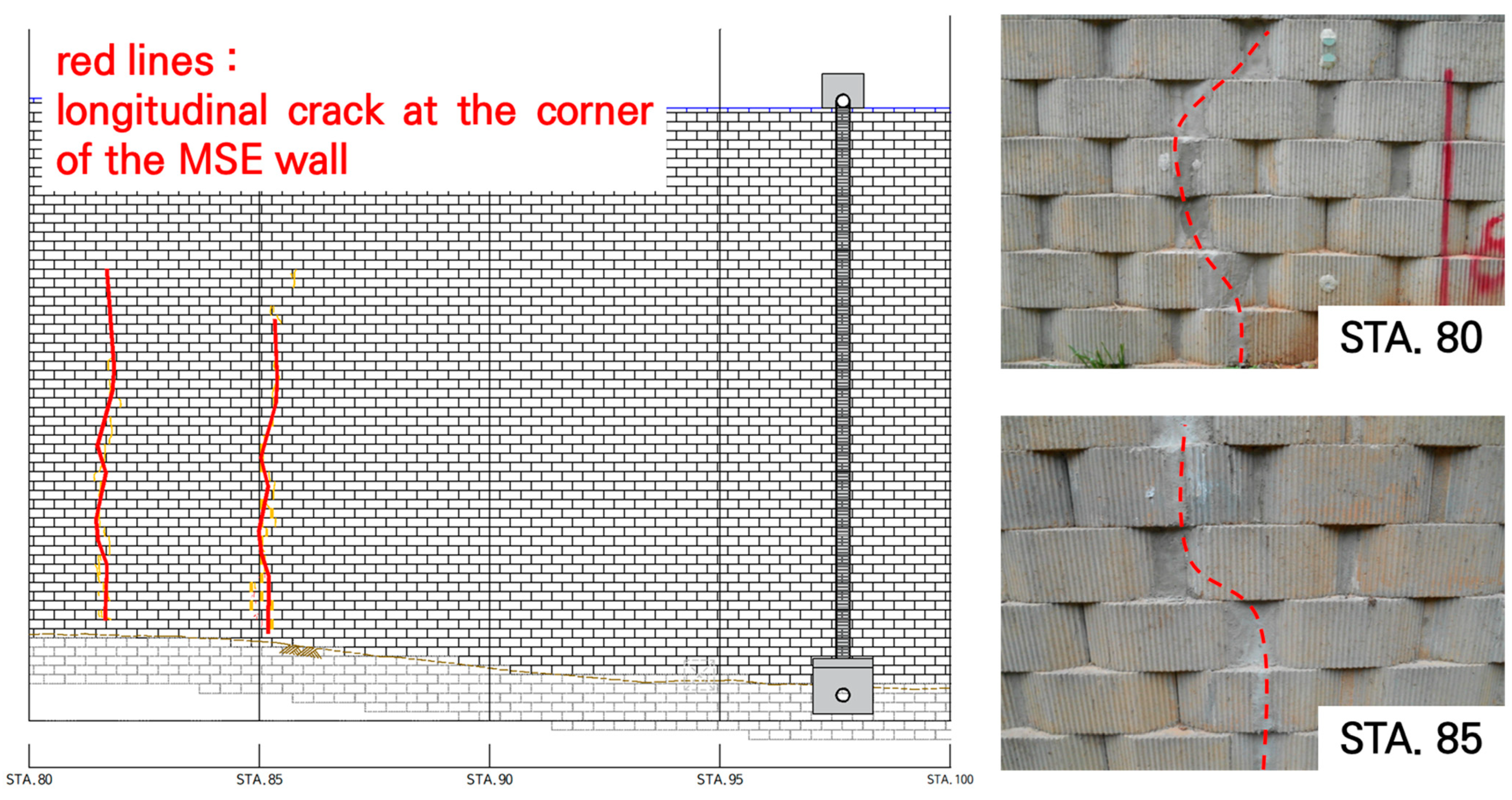

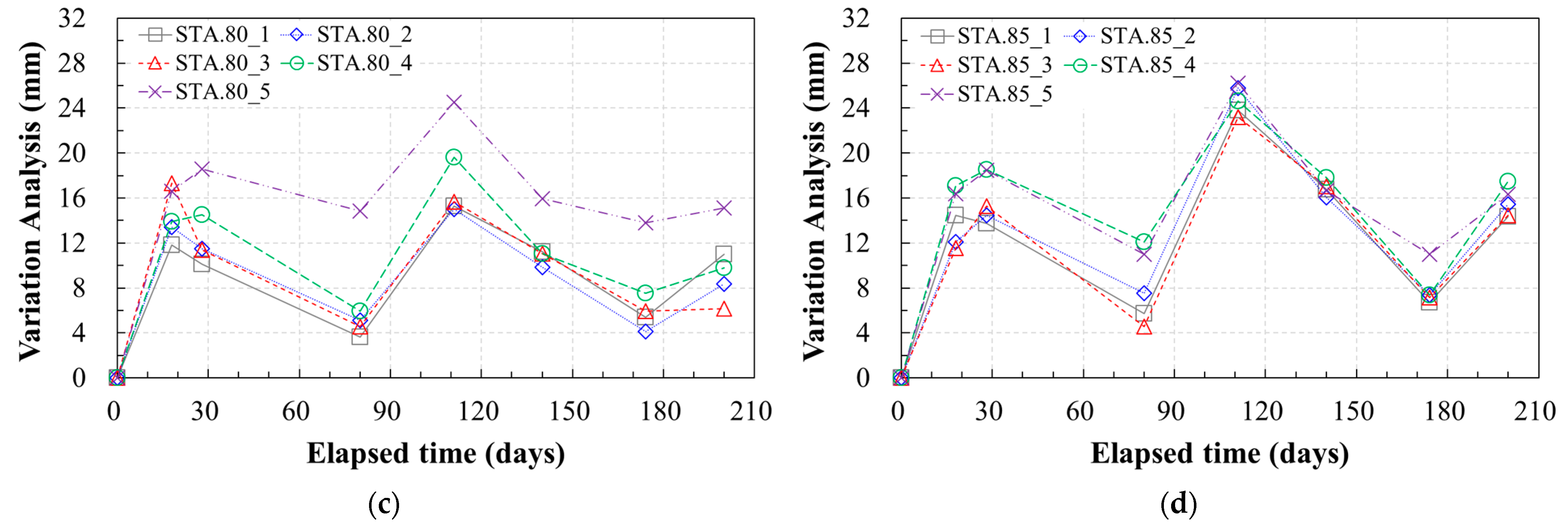
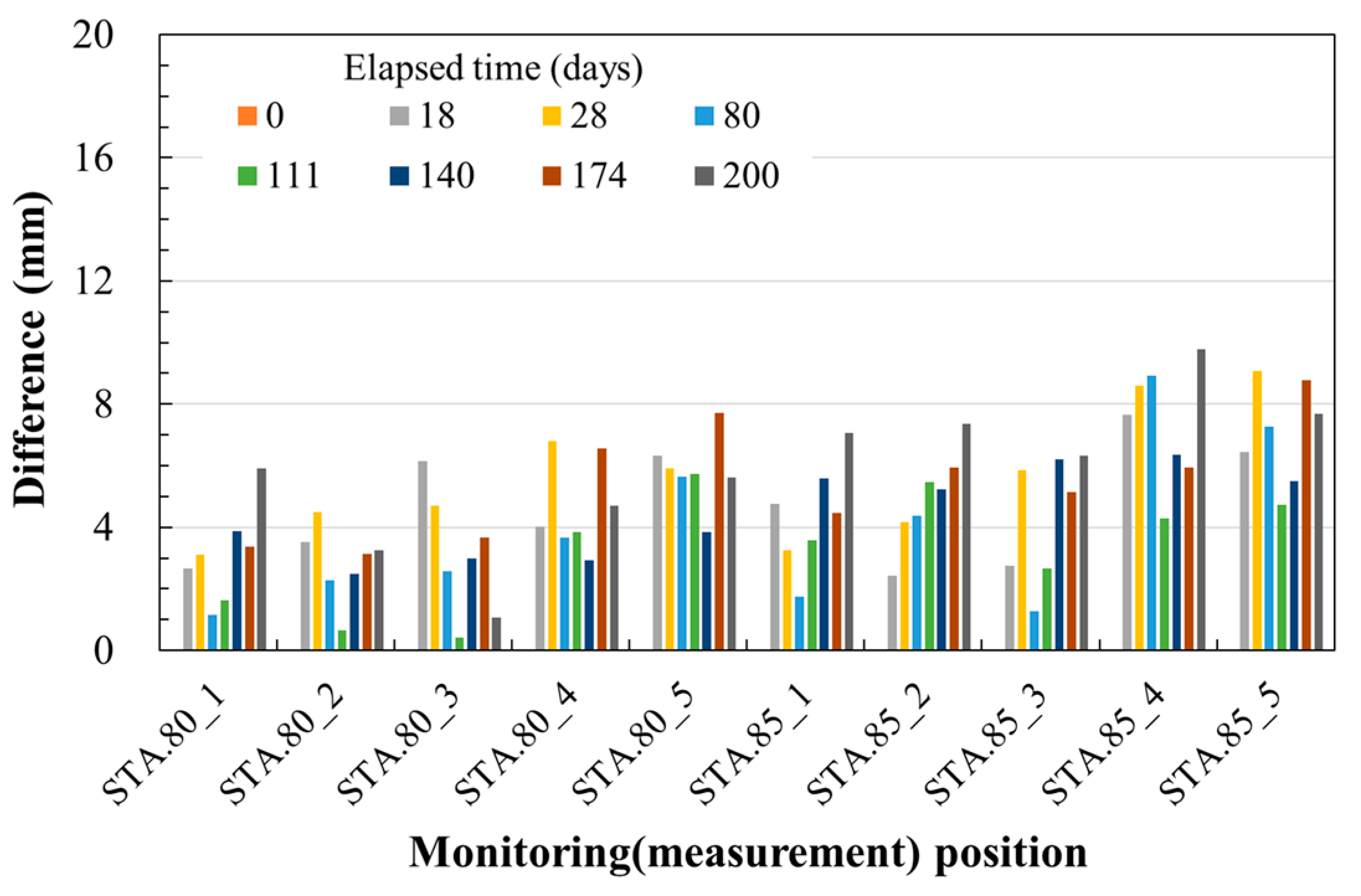
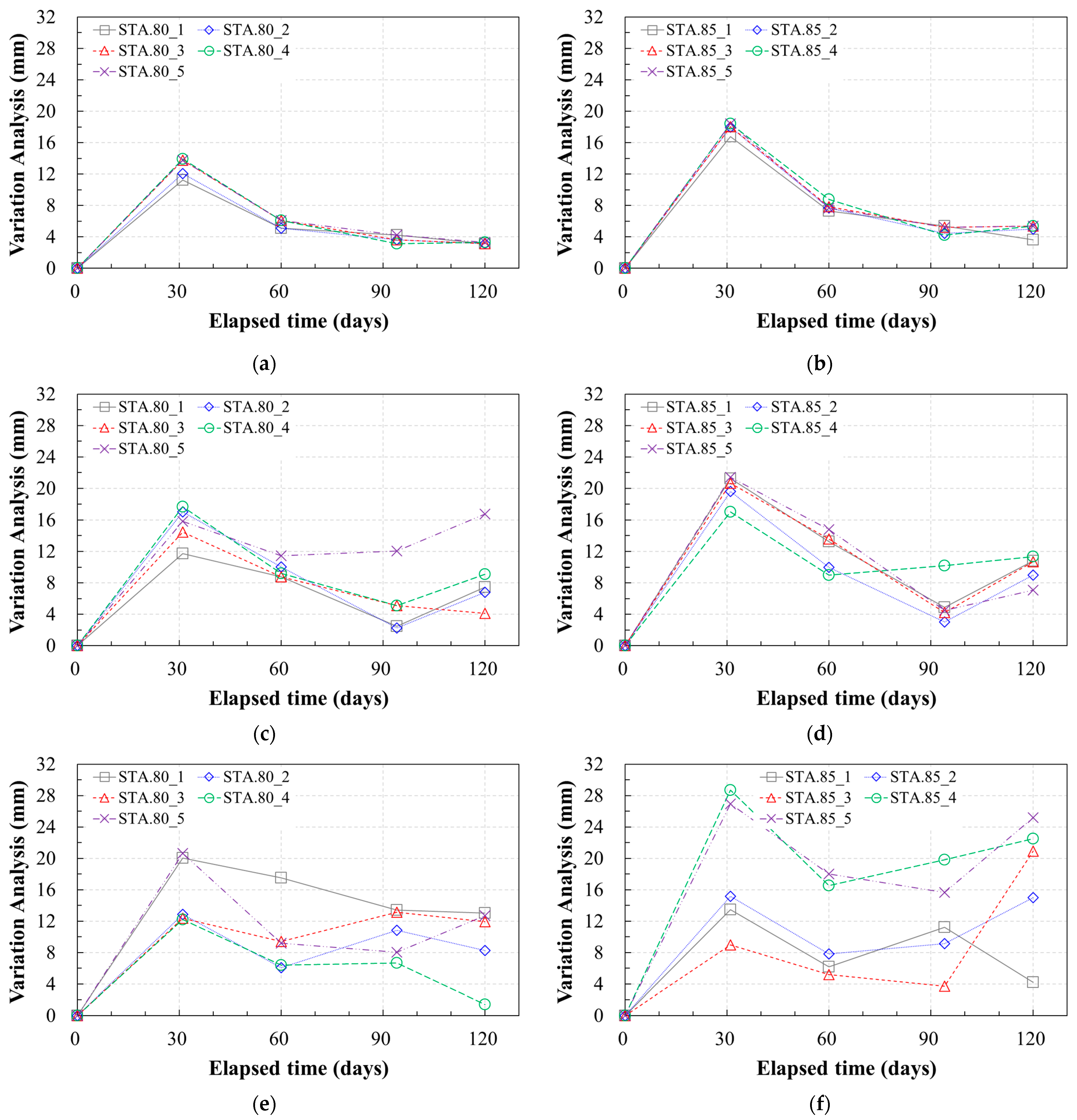
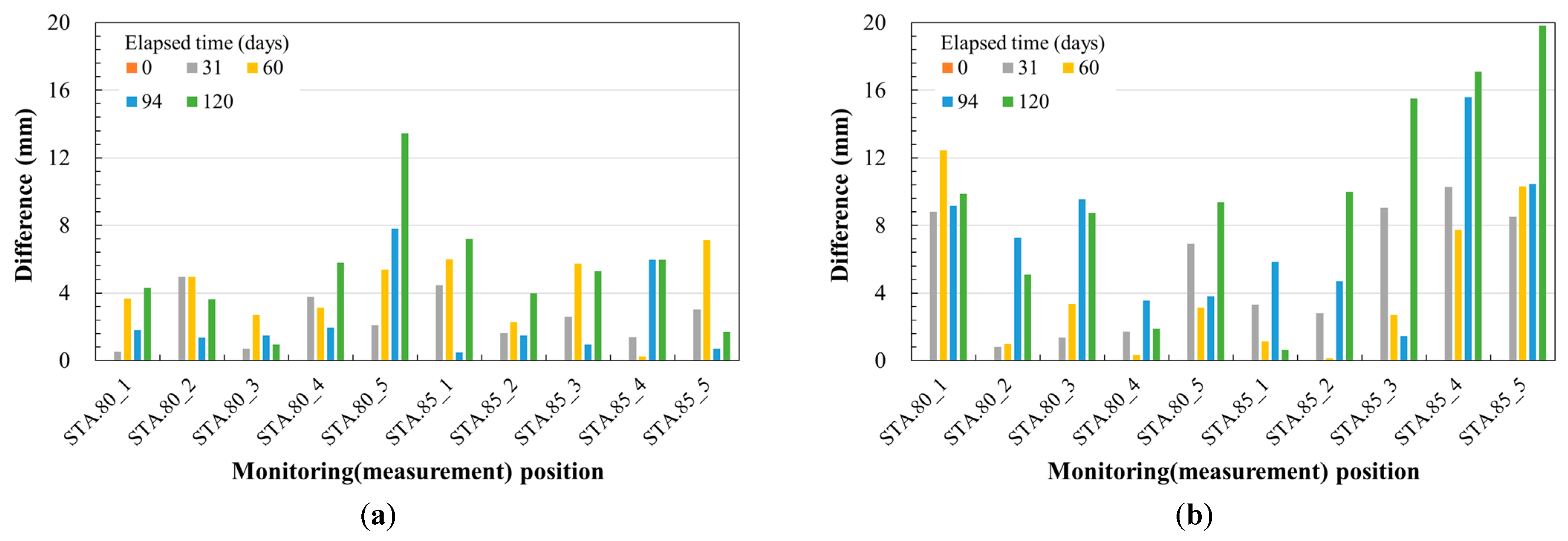

| Separation | Depth of Investigation (m) | Ground Layer | Remarks |
|---|---|---|---|
| TP-1 | 0.0 to 0.8 | Reclaimed soil layers | Straight |
| TP-2 | 0.0 to 1.0 | Corner (top) | |
| TP-3 | 0.0 to 0.5 | Corner (bottom) | |
| TP-4 | 0.0 to 0.3 | Topsoil layer | Original ground |
| Separation | wn (%) | Gs | Atterberg Limits | Grain Size Distribution (%) | USCS | Total Unit Weight () | Dry Unit Weight () | |||||
|---|---|---|---|---|---|---|---|---|---|---|---|---|
| LL (%) | PI (%) | #4 (4.75 mm) | #10 (2.00 mm) | #40 (0.425 mm) | #200 (0.075 mm) | 0.005 mm | ||||||
| TP-1 | 12.1 | 2.67 | -. | NP | 62.4 | 49.4 | 34.5 | 20.1 | 4.5 | SM | 19.94 | 17.79 |
| TP-2 | 20.9 | 2.68 | 31.4 | 5.6 | 83.0 | 75.0 | 65.3 | 43.2 | 9.5 | SM | 19.95 | 16.50 |
| TP-3 | 18.5 | 2.67 | 32.4 | 9.9 | 49.0 | 43.7 | 36.5 | 29.9 | 11.5 | GC | 22.41 | 18.91 |
| TP-4 | 28.1 | 2.68 | 40.8 | 18.2 | 100.0 | 100.0 | 90.6 | 70.4 | 23.0 | CL | 18.58 | 14.50 |
| Elapsed Time (Days) | Measurement Point | Traditional Monitoring (Total Station) | Digital Photogrammetry (Digital Camera) | Variation Analysis of Traditional Monitoring (mm) | Variation Analysis of Digital Photogrammetry (mm) | Difference (mm) | ||||
|---|---|---|---|---|---|---|---|---|---|---|
| X | Y | Z | X′ | Y′ | Z′ | |||||
| 0 | 80_1 | 1003.813 | 998.938 | 0.48 | 1003.81 | 998.942 | 0.481 | 0.000 | 0.000 | 0.000 |
| 80_2 | 1003.833 | 998.864 | 2.026 | 1003.833 | 998.869 | 2.021 | 0.000 | 0.000 | 0.000 | |
| 80_3 | 1003.843 | 998.828 | 2.811 | 1003.843 | 998.836 | 2.813 | 0.000 | 0.000 | 0.000 | |
| 80_4 | 1003.863 | 998.755 | 4.017 | 1003.859 | 998.77 | 4.025 | 0.000 | 0.000 | 0.000 | |
| 80_5 | 1003.888 | 998.655 | 5.211 | 1003.883 | 998.689 | 5.221 | 0.000 | 0.000 | 0.000 | |
| 85_1 | 999.089 | 996.596 | 0.541 | 999.085 | 996.602 | 0.539 | 0.000 | 0.000 | 0.000 | |
| 85_2 | 999.1 | 996.557 | 1.754 | 999.094 | 996.56 | 1.752 | 0.000 | 0.000 | 0.000 | |
| 85_3 | 999.165 | 996.497 | 3.735 | 999.165 | 996.505 | 3.734 | 0.000 | 0.000 | 0.000 | |
| 85_4 | 999.21 | 996.479 | 4.567 | 999.203 | 996.489 | 4.563 | 0.000 | 0.000 | 0.000 | |
| 85_5 | 999.2 | 996.388 | 5.751 | 999.196 | 996.398 | 5.748 | 0.000 | 0.000 | 0.000 | |
| 18 | 80_1 | 1003.821 | 998.94 | 0.484 | 1003.816 | 998.94 | 0.491 | 9.165 | 11.832 | 2.667 |
| 80_2 | 1003.842 | 998.865 | 2.03 | 1003.841 | 998.865 | 2.031 | 9.899 | 13.416 | 3.517 | |
| 80_3 | 1003.853 | 998.828 | 2.816 | 1003.857 | 998.826 | 2.815 | 11.180 | 17.321 | 6.140 | |
| 80_4 | 1003.872 | 998.756 | 4.021 | 1003.867 | 998.759 | 4.022 | 9.899 | 13.928 | 4.029 | |
| 80_5 | 1003.897 | 998.655 | 5.216 | 1003.879 | 998.673 | 5.223 | 10.296 | 16.613 | 6.318 | |
| 85_1 | 999.098 | 996.593 | 0.539 | 999.097 | 996.594 | 0.54 | 9.695 | 14.457 | 4.761 | |
| 85_2 | 999.108 | 996.552 | 1.752 | 999.105 | 996.555 | 1.752 | 9.644 | 12.083 | 2.439 | |
| 85_3 | 999.173 | 996.494 | 3.733 | 999.171 | 996.496 | 3.73 | 8.775 | 11.533 | 2.758 | |
| 85_4 | 999.219 | 996.477 | 4.565 | 999.215 | 996.477 | 4.561 | 9.434 | 17.088 | 7.654 | |
| 85_5 | 999.209 | 996.385 | 5.748 | 999.208 | 996.388 | 5.753 | 9.950 | 16.401 | 6.451 | |
| 28 | 80_1 | 1003.819 | 998.94 | 0.483 | 1003.82 | 998.941 | 0.482 | 7.000 | 10.100 | 3.100 |
| 80_2 | 1003.839 | 998.866 | 2.029 | 1003.841 | 998.867 | 2.029 | 7.000 | 11.489 | 4.489 | |
| 80_3 | 1003.849 | 998.828 | 2.814 | 1003.852 | 998.829 | 2.813 | 6.708 | 11.402 | 4.694 | |
| 80_4 | 1003.87 | 998.756 | 4.02 | 1003.872 | 998.766 | 4.02 | 7.681 | 14.491 | 6.810 | |
| 80_5 | 1003.894 | 998.666 | 5.213 | 1003.895 | 998.678 | 5.212 | 12.689 | 18.601 | 5.912 | |
| 85_1 | 999.099 | 996.595 | 0.544 | 999.096 | 996.6 | 0.547 | 10.488 | 13.748 | 3.260 | |
| 85_2 | 999.109 | 996.553 | 1.757 | 999.108 | 996.557 | 1.754 | 10.296 | 14.457 | 4.161 | |
| 85_3 | 999.173 | 996.493 | 3.738 | 999.174 | 996.493 | 3.737 | 9.434 | 15.297 | 5.863 | |
| 85_4 | 999.219 | 996.476 | 4.57 | 999.217 | 996.477 | 4.565 | 9.950 | 18.547 | 8.597 | |
| 85_5 | 999.208 | 996.384 | 5.754 | 999.207 | 996.384 | 5.753 | 9.434 | 18.493 | 9.059 | |
| 80 | 80_1 | 1003.815 | 998.939 | 0.479 | 1003.813 | 998.944 | 0.481 | 2.449 | 3.606 | 1.156 |
| 80_2 | 1003.835 | 998.866 | 2.026 | 1003.832 | 998.869 | 2.026 | 2.828 | 5.099 | 2.271 | |
| 80_3 | 1003.845 | 998.828 | 2.811 | 1003.847 | 998.835 | 2.815 | 2.000 | 4.583 | 2.583 | |
| 80_4 | 1003.865 | 998.756 | 4.017 | 1003.858 | 998.765 | 4.022 | 2.236 | 5.916 | 3.680 | |
| 80_5 | 1003.89 | 998.664 | 5.211 | 1003.883 | 998.679 | 5.21 | 9.220 | 14.866 | 5.647 | |
| 85_1 | 999.093 | 996.596 | 0.541 | 999.089 | 996.601 | 0.543 | 4.000 | 5.745 | 1.745 | |
| 85_2 | 999.103 | 996.556 | 1.754 | 999.101 | 996.558 | 1.754 | 3.162 | 7.550 | 4.388 | |
| 85_3 | 999.168 | 996.496 | 3.736 | 999.166 | 996.501 | 3.736 | 3.317 | 4.583 | 1.266 | |
| 85_4 | 999.213 | 996.479 | 4.568 | 999.21 | 996.48 | 4.567 | 3.162 | 12.083 | 8.921 | |
| 85_5 | 999.203 | 996.386 | 5.752 | 999.202 | 996.392 | 5.755 | 3.742 | 11.000 | 7.258 | |
| 111 | 80_1 | 1003.824 | 998.942 | 0.473 | 1003.824 | 998.948 | 0.482 | 13.638 | 15.264 | 1.626 |
| 80_2 | 1003.844 | 998.870 | 2.019 | 1003.843 | 998.858 | 2.019 | 14.353 | 15.000 | 0.647 | |
| 80_3 | 1003.855 | 998.833 | 2.803 | 1003.854 | 998.831 | 2.803 | 15.264 | 15.684 | 0.420 | |
| 80_4 | 1003.876 | 998.759 | 4.009 | 1003.871 | 998.766 | 4.01 | 15.780 | 19.621 | 3.842 | |
| 80_5 | 1003.901 | 998.666 | 5.203 | 1003.898 | 998.678 | 5.205 | 18.815 | 24.536 | 5.721 | |
| 85_1 | 999.107 | 996.590 | 0.534 | 999.106 | 996.592 | 0.534 | 20.224 | 23.791 | 3.567 | |
| 85_2 | 999.118 | 996.549 | 1.747 | 999.117 | 996.55 | 1.746 | 20.322 | 25.788 | 5.465 | |
| 85_3 | 999.183 | 996.490 | 3.728 | 999.182 | 996.49 | 3.729 | 20.543 | 23.216 | 2.674 | |
| 85_4 | 999.226 | 996.468 | 4.561 | 999.222 | 996.475 | 4.556 | 20.322 | 24.617 | 4.295 | |
| 85_5 | 999.216 | 996.375 | 5.745 | 999.213 | 996.379 | 5.742 | 21.471 | 26.192 | 4.721 | |
| 140 | 80_1 | 1003.82 | 998.940 | 0.479 | 1003.821 | 998.941 | 0.479 | 7.348 | 11.225 | 3.877 |
| 80_2 | 1003.84 | 998.866 | 2.025 | 1003.842 | 998.869 | 2.025 | 7.348 | 9.849 | 2.500 | |
| 80_3 | 1003.851 | 998.828 | 2.810 | 1003.851 | 998.829 | 2.81 | 8.062 | 11.045 | 2.983 | |
| 80_4 | 1003.871 | 998.756 | 4.016 | 1003.867 | 998.763 | 4.022 | 8.124 | 11.045 | 2.921 | |
| 80_5 | 1003.896 | 998.664 | 5.210 | 1003.888 | 998.674 | 5.219 | 12.083 | 15.937 | 3.854 | |
| 85_1 | 999.1 | 996.594 | 0.541 | 999.101 | 996.597 | 0.539 | 11.180 | 16.763 | 5.583 | |
| 85_2 | 999.11 | 996.553 | 1.753 | 999.11 | 996.561 | 1.751 | 10.817 | 16.062 | 5.246 | |
| 85_3 | 999.175 | 996.493 | 3.734 | 999.176 | 996.492 | 3.734 | 10.817 | 17.029 | 6.213 | |
| 85_4 | 999.221 | 996.476 | 4.566 | 999.216 | 996.477 | 4.561 | 11.446 | 17.804 | 6.359 | |
| 85_5 | 999.21 | 996.383 | 5.751 | 999.207 | 996.387 | 5.742 | 11.180 | 16.673 | 5.493 | |
| 174 | 80_1 | 1003.811 | 998.938 | 0.480 | 1003.814 | 998.945 | 0.479 | 2.000 | 5.385 | 3.385 |
| 80_2 | 1003.832 | 998.864 | 2.026 | 1003.834 | 998.869 | 2.025 | 1.000 | 4.123 | 3.123 | |
| 80_3 | 1003.842 | 998.826 | 2.811 | 1003.848 | 998.835 | 2.81 | 2.236 | 5.916 | 3.680 | |
| 80_4 | 1003.862 | 998.755 | 4.017 | 1003.863 | 998.765 | 4.021 | 1.000 | 7.550 | 6.550 | |
| 80_5 | 1003.887 | 998.661 | 5.211 | 1003.892 | 998.679 | 5.218 | 6.083 | 13.784 | 7.701 | |
| 85_1 | 999.088 | 996.598 | 0.541 | 999.091 | 996.599 | 0.539 | 2.236 | 6.708 | 4.472 | |
| 85_2 | 999.099 | 996.558 | 1.754 | 999.101 | 996.558 | 1.751 | 1.414 | 7.348 | 5.934 | |
| 85_3 | 999.163 | 996.497 | 3.735 | 999.166 | 996.498 | 3.733 | 2.000 | 7.141 | 5.141 | |
| 85_4 | 999.209 | 996.480 | 4.567 | 999.202 | 996.482 | 4.561 | 1.414 | 7.348 | 5.934 | |
| 85_5 | 999.198 | 996.387 | 5.751 | 999.198 | 996.392 | 5.757 | 2.236 | 11.000 | 8.764 | |
| 200 | 80_1 | 1003.818 | 998.939 | 0.480 | 1003.819 | 998.948 | 0.479 | 5.099 | 11.000 | 5.901 |
| 80_2 | 1003.838 | 998.865 | 2.026 | 1003.838 | 998.872 | 2.027 | 5.099 | 8.367 | 3.268 | |
| 80_3 | 1003.848 | 998.827 | 2.811 | 1003.849 | 998.837 | 2.812 | 5.099 | 6.164 | 1.065 | |
| 80_4 | 1003.868 | 998.755 | 4.016 | 1003.867 | 998.766 | 4.021 | 5.099 | 9.798 | 4.699 | |
| 80_5 | 1003.893 | 998.663 | 5.210 | 1003.897 | 998.685 | 5.217 | 9.487 | 15.100 | 5.613 | |
| 85_1 | 999.096 | 996.594 | 0.541 | 999.096 | 996.593 | 0.541 | 7.280 | 14.353 | 7.073 | |
| 85_2 | 999.107 | 996.553 | 1.754 | 999.109 | 996.562 | 1.755 | 8.062 | 15.427 | 7.365 | |
| 85_3 | 999.172 | 996.493 | 3.734 | 999.173 | 996.493 | 3.735 | 8.124 | 14.457 | 6.333 | |
| 85_4 | 999.217 | 996.476 | 4.566 | 999.218 | 996.481 | 4.559 | 7.681 | 17.464 | 9.783 | |
| 85_5 | 999.207 | 996.383 | 5.750 | 999.203 | 996.385 | 5.755 | 8.660 | 16.340 | 7.680 | |
| Elapsed Time (Days) | Measurement Point | Variation Analysis of Traditional Monitoring (Total Station) (mm) | Variation Analysis of Digital Image Photogrammetry (Digital Camera) (mm) | Variation Analysis of Digital Image Photogrammetry (Cellphone Camera) (mm) | Difference between Traditional Monitoring and Digital Image Photogrammetry (Digital Camera) (mm) | Difference between Traditional Monitoring and Digital Image Photogrammetry (Cellphone Camera) (mm) |
|---|---|---|---|---|---|---|
| 0 | 80_1 | 0.000 | 0.000 | 0.000 | 0.000 | 0.000 |
| 80_2 | 0.000 | 0.000 | 0.000 | 0.000 | 0.000 | |
| 80_3 | 0.000 | 0.000 | 0.000 | 0.000 | 0.000 | |
| 80_4 | 0.000 | 0.000 | 0.000 | 0.000 | 0.000 | |
| 80_5 | 0.000 | 0.000 | 0.000 | 0.000 | 0.000 | |
| 85_1 | 0.000 | 0.000 | 0.000 | 0.000 | 0.000 | |
| 85_2 | 0.000 | 0.000 | 0.000 | 0.000 | 0.000 | |
| 85_3 | 0.000 | 0.000 | 0.000 | 0.000 | 0.000 | |
| 85_4 | 0.000 | 0.000 | 0.000 | 0.000 | 0.000 | |
| 85_5 | 0.000 | 0.000 | 0.000 | 0.000 | 0.000 | |
| 31 | 80_1 | 11.225 | 11.747 | 20.025 | 0.522 | 8.800 |
| 80_2 | 12.083 | 17.059 | 12.884 | 4.976 | 0.801 | |
| 80_3 | 13.748 | 14.457 | 12.369 | 0.709 | 1.378 | |
| 80_4 | 13.928 | 17.720 | 12.207 | 3.792 | 1.722 | |
| 80_5 | 13.748 | 15.843 | 20.664 | 2.095 | 6.916 | |
| 85_1 | 16.763 | 21.237 | 13.454 | 4.474 | 3.309 | |
| 85_2 | 17.972 | 19.596 | 15.166 | 1.624 | 2.806 | |
| 85_3 | 18.028 | 20.640 | 9.000 | 2.612 | 9.028 | |
| 85_4 | 18.412 | 17.029 | 28.705 | 1.383 | 10.293 | |
| 85_5 | 18.412 | 21.424 | 26.926 | 3.012 | 8.514 | |
| 60 | 80_1 | 5.099 | 8.775 | 17.521 | 3.676 | 12.422 |
| 80_2 | 5.099 | 10.050 | 6.083 | 4.951 | 0.984 | |
| 80_3 | 6.083 | 8.775 | 9.434 | 2.692 | 3.351 | |
| 80_4 | 6.083 | 9.220 | 6.403 | 3.137 | 0.320 | |
| 80_5 | 6.083 | 11.446 | 9.220 | 5.363 | 3.137 | |
| 85_1 | 7.280 | 13.266 | 6.164 | 5.986 | 1.116 | |
| 85_2 | 7.681 | 9.950 | 7.810 | 2.269 | 0.129 | |
| 85_3 | 7.874 | 13.601 | 5.196 | 5.727 | 2.678 | |
| 85_4 | 8.775 | 9.000 | 16.523 | 0.225 | 7.748 | |
| 85_5 | 7.681 | 14.799 | 18.000 | 7.118 | 10.319 | |
| 94 | 80_1 | 4.243 | 2.449 | 13.416 | 1.793 | 9.174 |
| 80_2 | 3.606 | 2.236 | 10.863 | 1.369 | 7.257 | |
| 80_3 | 3.606 | 5.099 | 13.153 | 1.493 | 9.547 | |
| 80_4 | 3.162 | 5.099 | 6.708 | 1.937 | 3.546 | |
| 80_5 | 4.243 | 12.042 | 8.062 | 7.799 | 3.820 | |
| 85_1 | 5.385 | 4.899 | 11.225 | 0.486 | 5.840 | |
| 85_2 | 4.472 | 3.000 | 9.165 | 1.472 | 4.693 | |
| 85_3 | 5.196 | 4.243 | 3.742 | 0.954 | 1.454 | |
| 85_4 | 4.243 | 10.198 | 19.824 | 5.955 | 15.582 | |
| 85_5 | 5.196 | 4.472 | 15.652 | 0.724 | 10.456 | |
| 120 | 80_1 | 3.162 | 7.483 | 13.038 | 4.321 | 9.876 |
| 80_2 | 3.162 | 6.782 | 8.246 | 3.620 | 5.084 | |
| 80_3 | 3.162 | 4.123 | 11.916 | 0.961 | 8.754 | |
| 80_4 | 3.317 | 9.110 | 1.414 | 5.794 | 1.902 | |
| 80_5 | 3.317 | 16.763 | 12.689 | 13.446 | 9.372 | |
| 85_1 | 3.606 | 10.817 | 4.243 | 7.211 | 0.637 | |
| 85_2 | 5.000 | 9.000 | 15.000 | 4.000 | 10.000 | |
| 85_3 | 5.385 | 10.677 | 20.905 | 5.292 | 15.519 | |
| 85_4 | 5.385 | 11.358 | 22.494 | 5.973 | 17.109 | |
| 85_5 | 5.385 | 7.071 | 25.199 | 1.686 | 19.814 |
Disclaimer/Publisher’s Note: The statements, opinions and data contained in all publications are solely those of the individual author(s) and contributor(s) and not of MDPI and/or the editor(s). MDPI and/or the editor(s) disclaim responsibility for any injury to people or property resulting from any ideas, methods, instructions or products referred to in the content. |
© 2024 by the authors. Licensee MDPI, Basel, Switzerland. This article is an open access article distributed under the terms and conditions of the Creative Commons Attribution (CC BY) license (https://creativecommons.org/licenses/by/4.0/).
Share and Cite
Choi, C.-H.; Han, J.-G.; Hong, G. Applicability of Digital Image Photogrammetry to Rapid Displacement Measurements of Structures in Restricted-Access and Controlled Areas: Case Study in Korea. Appl. Sci. 2024, 14, 5295. https://doi.org/10.3390/app14125295
Choi C-H, Han J-G, Hong G. Applicability of Digital Image Photogrammetry to Rapid Displacement Measurements of Structures in Restricted-Access and Controlled Areas: Case Study in Korea. Applied Sciences. 2024; 14(12):5295. https://doi.org/10.3390/app14125295
Chicago/Turabian StyleChoi, Chang-Hwan, Jung-Geun Han, and Gigwon Hong. 2024. "Applicability of Digital Image Photogrammetry to Rapid Displacement Measurements of Structures in Restricted-Access and Controlled Areas: Case Study in Korea" Applied Sciences 14, no. 12: 5295. https://doi.org/10.3390/app14125295
APA StyleChoi, C.-H., Han, J.-G., & Hong, G. (2024). Applicability of Digital Image Photogrammetry to Rapid Displacement Measurements of Structures in Restricted-Access and Controlled Areas: Case Study in Korea. Applied Sciences, 14(12), 5295. https://doi.org/10.3390/app14125295







